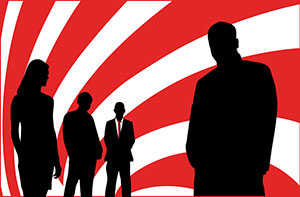| |

by Bob Duffy |
 Can your team adapt when opportunities and conditions demand it? In broader terms, does your organization have the ‘right stuff’ to innovate successfully? This should be among the most important questions leaders ask as they assess their organizations’ readiness for the changing demands of operational success today. Can your team adapt when opportunities and conditions demand it? In broader terms, does your organization have the ‘right stuff’ to innovate successfully? This should be among the most important questions leaders ask as they assess their organizations’ readiness for the changing demands of operational success today.
The answer tells the tale on the critical value of strategic human capital management in high-performance organizations in both private and public sectors.
Systematic talent management is central to sustained performance and innovation. For starters, managing your human capital strategically means:
-
Identifying and anticipating needs for specific skills and pinpointing where these skills can be found
-
Attracting individuals with the kinds of talent and personal qualities to succeed in your culture
-
Aligning your full workforce with corporate strategy, and
-
Retaining and developing high performing team members.
It’s a no-brainer to point out that you should tailor all your people programs— for recruiting, retention, training, team-building, and so on—to your business case, strategy, and operational priorities. And this is no less true today if you’re an association, a not-for-profit organization, or even a government agency. But consider this: building on the spirit and shared values that motivate your employees has a lot to do with sustained success in your markets or other spheres of influence.
A sense of community lies at the heart of each brand.
This may seem like an abstract and insubstantial basis for serious strategic planning, but what we’ve discovered with brand communities in the marketplace illustrates just how influential these intangibles can be. Consider Starbucks, Apple Computer, and Harley Davidson, to cite just a few current examples. A sense of community lies at the heart of each brand. For many individuals in these brand communities, this felt sense of belonging is as important as the quality of the organization’s products or services.
Brand power emerges from community and shared values.
There’s good reason to apply what we’ve learned about marketplace brands to the workplace. If an organization’s brand can attract a marketplace community that embraces and shapes the values that the brand represents, why shouldn’t we view an organization’s workforce as a parallel brand community in its own right?
This is the premise of talent branding, which takes a different tack than the employer brands’ familiar from HR practice for a decade or more. For the most part, this approach molded itself on the market-facing perspective of packaged goods brands.
A talent brand should be authentic from the inside out.
Employer brands generally paid little attention to their native corporate cultures or the notion that unique values, held in common, can boost an organization’s performance. The employer’s generalized perception of the preferences of its target segment, i.e. its potential recruits, were permitted to dominate how the organization positioned itself as a place to work.
Case in point: in the heady days of the dot-com bubble recruiters generalized that the casual workplace—with its laissez faire approach to schedules, attire, and workplace décor—would appeal in a big way to technical professionals, and especially to Web-savvy twenty-somethings. Before long even staid and established companies were hyping their workout rooms, their air hockey lounges, their pet-friendly policies, and so on.
Where these environments authentically embody the top-to-bottom spirit of the company—at Google, say, or Monster.com—this made perfect sense.
But for many companies, this positioning proved inauthentic and forced, a flimsy affectation that wouldn’t stick. In their scramble to join the Net revolution, organizations were inadvertently screening out their earned’ attributes, the distinct operating values and self-defined sense of community that made their workplaces—and their workforces— special.
A talent brand differs from nineties-style employer brands in that it anchors its appeal in the unique attributes that an organization offers, not in what it presumes its target expects from a workplace. In a nutshell, it starts at the opposite end of the supply/demand curve.
The premise is that if you demonstrate your workplace’s culture and values, the best qualified applicants will self-select.
 Google is an illuminating case. The company thrives on what appears to be a hyper-casual environment, but a closer look reveals much more. Google is a magnet employer for lots of reasons, but much of its drawing power derives from its expansive, high-concept notion of the work setting: working at Google distinguishes you as a resident of a self-contained 24/7 workplace community, and an elite one at that. This is a powerful attractor for many high achieving candidates. For the relatively tiny percentage of the million-plus yearly applicants who survive Google’s rigorous screening, the company’s on-the-job culture imparts a sense of belonging to an elite and prestigious team, and fosters deep personal connections to corporate values and strategy. Google is an illuminating case. The company thrives on what appears to be a hyper-casual environment, but a closer look reveals much more. Google is a magnet employer for lots of reasons, but much of its drawing power derives from its expansive, high-concept notion of the work setting: working at Google distinguishes you as a resident of a self-contained 24/7 workplace community, and an elite one at that. This is a powerful attractor for many high achieving candidates. For the relatively tiny percentage of the million-plus yearly applicants who survive Google’s rigorous screening, the company’s on-the-job culture imparts a sense of belonging to an elite and prestigious team, and fosters deep personal connections to corporate values and strategy.
The ideal talent brand finds its power in the organization’s top-line business focus, its workplace culture, and, ultimately, in the shared values it embodies.
In Google’s case, all this is entirely consonant with the company’s marketplace brand. Its inside and outside brands, if you will, have co-evolved in parallel, and as much intuitively as consciously.
Is there a better way to attract the candidates most qualified and inclined by their own values and temperaments to contribute to an organization’s future? But to succeed in this pursuit organizations have to take responsibility for defining their own distinctive talent brands. For most—and particularly for established companies that aren’t building corporate cultures from the ground up à la Google.
An authentic talent brand has to emerge from honest discovery from within.
And this is rarely a simple and straightforward proposition in established organizations, and not always a painless one either. This collective discovery can emerge from many activities: interviews with leadership and staff, formal or informal focus groups, and online surveys of employees, to name a few. And while the perspectives of outside segments should not drive the effort, they can support it. Best practices among similar organizations can provide useful models too.
Primary research into the strength of the organization’s appeal as a potential employer Is also a helpful benchmarking tool. But it’s essential to use these market findings to support, not mold, your organization’s talent brand.
Don’t just recruit—anchor all of your workplace culture in the brand.
A talent brand is not just about recruiting. If it accurately touches on the collective values and personality of a workplace culture, why not frame it as the basis for all human capital activities? This is where its most telling strategic value emerges, and where recruitment-centric employer brands inevitably fall short.
A talent brand can contribute in tangible and practical ways to improving performance.
It can spur culturally authentic programs to develop and retain talent, to align the workforce on corporate goals and strategy, and to drive initiatives for inclusion, change management, corporate oral tradition, and workforce planning, among many others.
In all cases, a talent brand should be the basis for concrete human capital programs that build or reinforce organizational culture. This is equally true if your organization’s talent brand turns out to be a work-in-progress. No corporate culture is flawlessly homogeneous, and a brand platform can become the fulcrum for breakthrough human capital strategies.
In all cases, a talent brand should be the basis for concrete human capital programs that build or reinforce organizational culture.
Like all ‘big idea’ brands, it has to be more than a premise for advertising and promotion.
An evolving talent brand can pay strategic and operational dividends for all sorts of organizations, including non-profits and public agencies. Think of it as a window on how well your organization’s underlying intellectual capital supports its real-world performance. In this light it becomes a valuable metric for assessing execution, adaptation, and innovation.
If you’re willing to explore and build, you will find a powerful asset in your workforce.
The watchword is community. The same communal motor behind many of the strongest market-facing brands today can also drive corporate innovation from the inside out. Communities co-create and reinforce brand positions. So don’t just look outside the walls of your organization to identify and empower these important segments. If you’re willing to explore and build, you will find a powerful asset in your workforce.
To learn more about our innovation programs, visit www.innovationcultures.com
© 2011 Intervista Inc.
<back to eLounge main page |
|
Untitled Document
innovationcultures
the future > faster
Executive Online Program
As an innovation leader or a professional, managing change is a fact of life. Our executive program will put the resources at your finger tips to help your team manage the future faster.

Innovation Boot Camp
Empower your team with this on-site session. Ideal for teams responsible for product and service innovation.
Services Innovation
for the
Public Sector
In this 2-day interactive session, your team will develop innovation and design thinking capabilities.
Contact us to schedule an on-site team session for your organization call Intervista at 1-800-397-9744.
Outside North America, call
(514)937-7130.
|

![]()
![]()

![]()
![]()